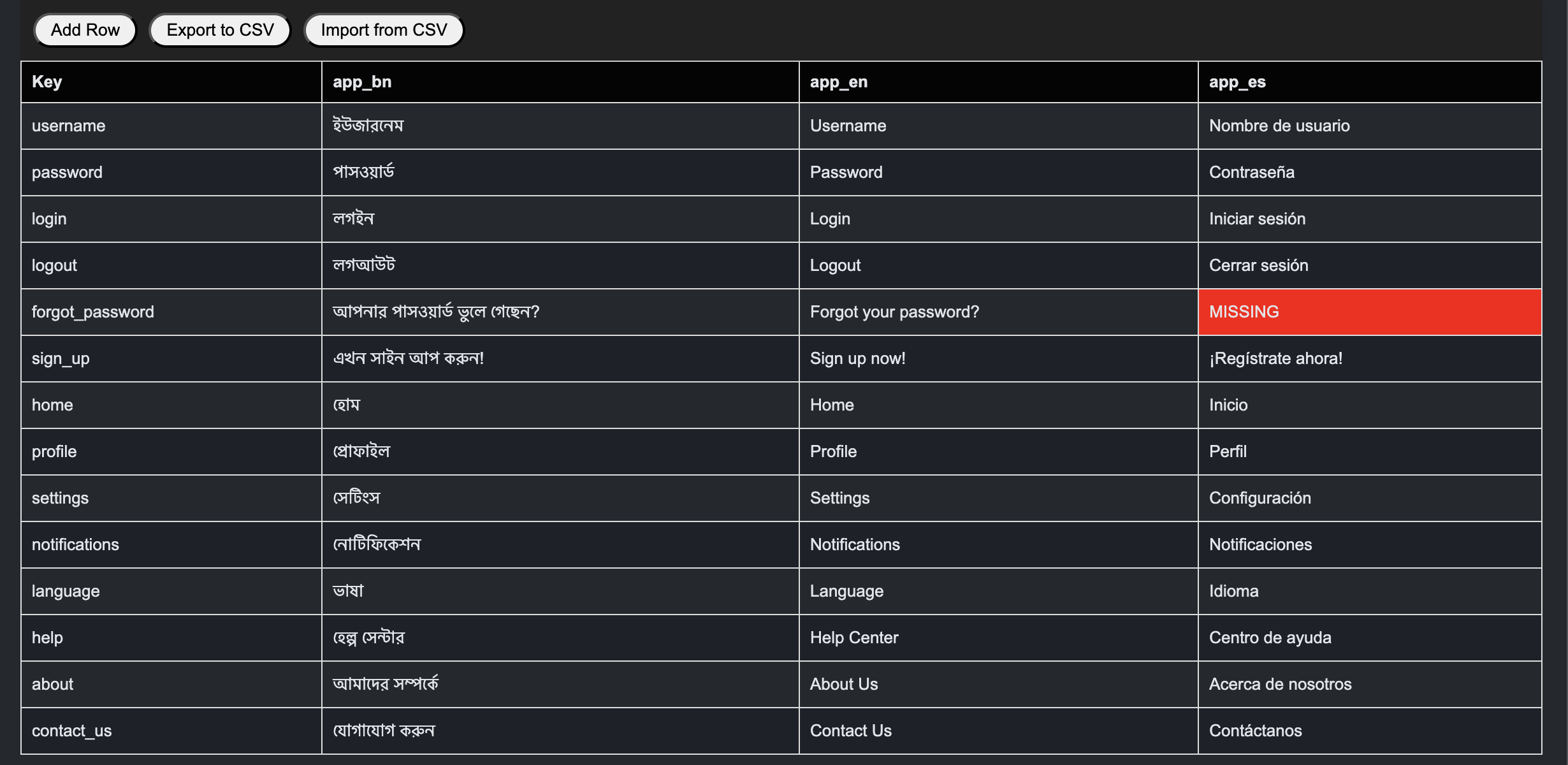https://github.com/utpal-barman/arb-tool-vscode-plugin
🛠️ Manage ARB files 🌐 right from your VSCode IDE
https://github.com/utpal-barman/arb-tool-vscode-plugin
application-resource-bundle arb arb-files internationalization localization localization-management localization-tool vscode vscode-extension
Last synced: 23 days ago
JSON representation
🛠️ Manage ARB files 🌐 right from your VSCode IDE
- Host: GitHub
- URL: https://github.com/utpal-barman/arb-tool-vscode-plugin
- Owner: utpal-barman
- License: mit
- Created: 2024-12-21T09:52:48.000Z (10 months ago)
- Default Branch: main
- Last Pushed: 2024-12-26T17:58:33.000Z (9 months ago)
- Last Synced: 2025-05-20T12:53:57.177Z (5 months ago)
- Topics: application-resource-bundle, arb, arb-files, internationalization, localization, localization-management, localization-tool, vscode, vscode-extension
- Language: TypeScript
- Homepage: https://marketplace.visualstudio.com/items?itemName=UtpalBarman.arb-manager
- Size: 538 KB
- Stars: 1
- Watchers: 1
- Forks: 0
- Open Issues: 1
-
Metadata Files:
- Readme: README.md
- Changelog: CHANGELOG.md
- License: LICENSE
Awesome Lists containing this project
README
# ARB Manager - VSCode Plugin
_Extract Strings, View ARBs in Table and more..._
The **ARB Manager Plugin** helps the management of ARB (Application Resource Bundle) files, enabling developers to manage ARB files within a simple and intuitive interface.
## Features
### 1. Extract Hardcoded Strings to ARB Files
- Right-click any hardcoded text in your codebase and select **Extract String to ARB File**. It will replace the hardcoded string with l10n.your_entered_key, define l10n according to your project tech stack in a variable.

For example, in a Flutter project, if you are using `flutter_localizations` from the Flutter SDK, you can define:
```dart
final l10n = AppLocalizations.of(context);
```
Or, if you use an extension on `BuildContext`, you can define:
```dart
final l10n = context.localizations;
```
### Flutter Guys
By default, if you have a Flutter project and do not have `flutter_localizations` set up, congratulations! With just a simple command, you can set it all up! But before doing so, make sure you're in a Git repository so you can always go back if needed, because this plugin will start writing code for you! 😉
To set it up, just type `Cmd` + `Shift` + `P` (or `Ctrl` + `Shift` + `P` on Windows) and type **"Setup flutter_localization"**. The plugin will suggest the setup for you—just press **Yes**. Boom! You’ll have `flutter_localizations` ready with one `.arb` file. If you want multiple `.arb` files, you can duplicate the `.arb` file, rename it, and make sure to change the `@@locale` language code accordingly.
Alternatively, if you prefer to manually configure it, that's also fine, or maybe you already have it set up.
- On first use, locate your ARB files in the project folder. Use naming conventions like `app_en.arb` or `en.arb` for automatic locale detection.
Note: Translation doesn't occur automatically, you have to replace the strings manually follwoing your business requirement, auto translate may lead wrong translate, but we have a plan to add a flag if user wants auto translate in future.
** If you face issues with locating wrong arb folder or later at some point you decided to move ARB files on a different location, use `cmd` + `shift` + `p` and type `Clear ARB Folder Path` and try again to extract string, it will ask you again to select the correct ARB folder location.
### 2. View and Edit Translations
- Display all ARB files in a tabular format.
- Edit translations directly within the table.
- Highlight missing translations for easy identification.

### 3. Add New Translation Keys
- Add new keys dynamically, ensuring key uniqueness.
- Missing translations are highlighted automatically.
### 4. Import and Export Translations
- Import translations from a CSV file.
- Export current translations to a CSV file for external editing or backup.
## Usage
### Prerequisites
This plugin requires that ARB files are already set up in your project. You can then use ARB keys and classes to render strings on the UI.
### Steps to Use
#### 1. Extract Strings to ARB Files
- Select hardcoded text, right-click, and choose **Extract String to ARB File**.
- Locate ARB files when prompted on the first use.
#### 2. View ARB Files
- Locate an ARB file in the project explorer.
- Right-click and select **View ARB File** to open it in a table view.
#### 3. Edit Translations
- Click any table cell to edit its content.
- Changes save automatically when moving to another cell.
#### 4. Add New Keys
- Click **Add Row** to create a new translation key.
- Enter the key and translations, then click **Save** to confirm or **Cancel** to discard changes.
#### 5. Import and Export
- Use the **Import** button to upload a CSV file with translations.
- Use the **Export** button to download current translations as a CSV file.
## Contributing
Contributions are welcome! Follow these steps:
1. Fork the repository.
2. Create a new branch for your feature or bug fix.
3. Submit a pull request with a clear explanation of your changes.
> **Note:** Follow [Conventional Commit](https://www.conventionalcommits.org/) guidelines for PR titles and commit messages.
## License
This project is licensed under the [MIT License](LICENSE).